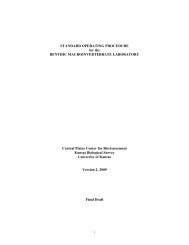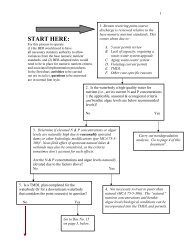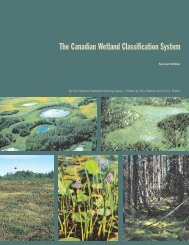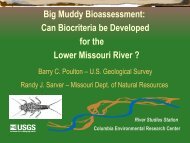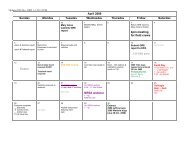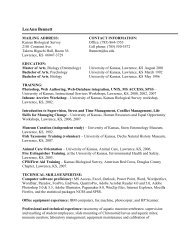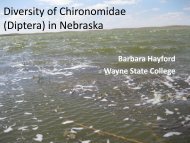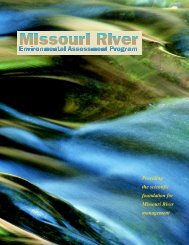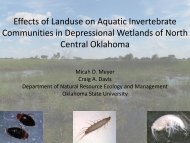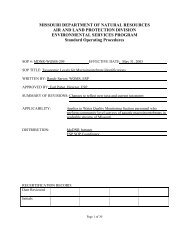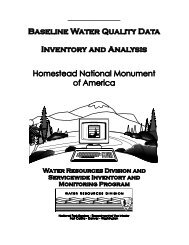Koontz, J., D.G. Huggins, C.C. Freeman, D.S. Baker - Central Plains ...
Koontz, J., D.G. Huggins, C.C. Freeman, D.S. Baker - Central Plains ...
Koontz, J., D.G. Huggins, C.C. Freeman, D.S. Baker - Central Plains ...
You also want an ePaper? Increase the reach of your titles
YUMPU automatically turns print PDFs into web optimized ePapers that Google loves.
Count SSS Intolerant Taxa<br />
Count HM Intolerant Taxa<br />
12<br />
11<br />
10<br />
9<br />
8<br />
7<br />
6<br />
5<br />
4<br />
3<br />
2<br />
1<br />
0<br />
25<br />
20<br />
15<br />
10<br />
5<br />
0<br />
a<br />
1 2<br />
Study Phase<br />
c<br />
1 2<br />
Study Phase<br />
Percent Hydroptilidae<br />
Percent Burrowers<br />
Figure 46. Box plots of macroinvertebrate metrics shown to be significantly different in<br />
ANOVA testing for population differences. (a) Count of Taxa Intolerant to Suspended Solids<br />
and Sediments (SSS). (b) Percent Hydroptilidae. (c) Count of Taxa Intolerant to Heavy Metals<br />
(HM). (d) Percent Burrowers. Box area represents inner quartile range, while “whiskers”<br />
represent the upper and lower observations.<br />
Metric Correlations<br />
The metrics selected after ANOVA testing were found to have significant relationships to many wetland<br />
water quality parameters and floristic quality values. While correlation does necessarily mean<br />
causation, most of the variability in the metrics were thought to be the result of either indirect or direct<br />
biological responses associated with these water quality and floristic factors. Many important water<br />
quality measures were correlated with multiple macroinvertebrate metrics, suggesting these metrics may<br />
have broad application as water quality indicators for wetland systems.<br />
Percent Hydroptilidae was significantly correlated with depth to flood (DTF), mean specific<br />
conductivity, total organic carbon (TOC), dissolved organic carbon (DOC), and atrazine metabolite<br />
desisopropylatrazine (DIA), and desethylatrazine (DEA) (Table 13). However, for many samples<br />
collected during Phases I and II, the value of this metric was zero. Then these samples were removed<br />
from the analysis, only mean conductivity, TOC, and DIA were found to be significantly correlated to<br />
Percent Hydroptilidae. A robust regression model explained over 40% of the variation in Percent<br />
Hydroptilidae (adjusted R 2 =0.41).<br />
10<br />
1<br />
.1<br />
100<br />
90<br />
80<br />
70<br />
60<br />
50<br />
40<br />
30<br />
20<br />
10<br />
0<br />
64 of 84<br />
b<br />
1 2<br />
Study Phase<br />
d<br />
1 2<br />
Study Phase



